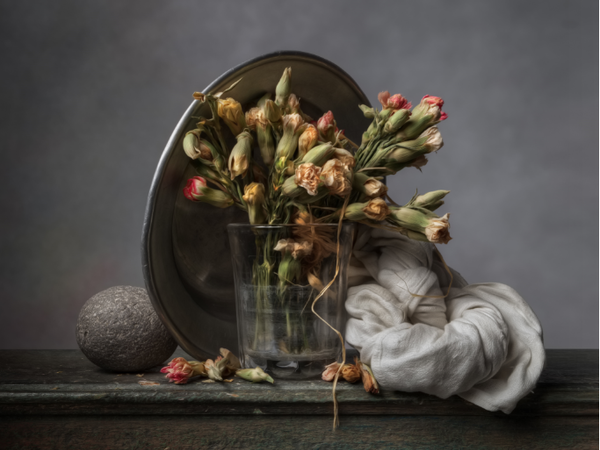In Brescia the exhibition of Christopher Broadbent, the photographer who shoots like a Flemish painter.
From June 6 to August 2, Ma.Co.f - Center of Italian Photography in Brescia is hosting the exhibition The Great Enchantment, a solo show by Christopher Broadbent (London, 1936), curated by Mario Trevisan and Renato Corsini.
The exhibition, consisting of thirty-six photographs distributed in four rooms, is an excursus in the still life photographic work of Broadbent, who has made the study of light one of the main tools in the realization of his images. Broadbent uses view camera and digital Leica indifferently in his work, and each shot is derived from a thorough study of perspective planes and the separation of tones in chiaroscuro, following the principle of a single light source. The use of the view camera and very long times literally allows things to happen: the objects depicted take a real life path on the set, immortalized at the moment of abandonment: “I worked for decades on editorial and advertising splendor, now I describe simple, forgotten things waiting in the half-light for accommodation.” The final act of printing is a step to which the photographer devotes meticulous craftsmanship to return a legible result that emphasizes the material component of his subjects.
What Remains. Stories of scullery is the title of the series presented in the exhibition. Through his compositions, the photographer contrasts natural elements with inanimate, shelved or forgotten ones, achieving a visual result that echoes the essential forms of traditional still life, orthogonal vision and chiaroscuro drawing. Christopher Broadbent mainly uses a wooden camera, natural light and very dilated times, leaving room for the change of light and content.
Broadbent’s favored subjects for his still lives are elements of the plant world, decaying flowers and everyday refectory or kitchen utensils, poor metal being an important element in the rendering of the images and the concreteness that characterizes them. Unprecedented, finally, is the room that closes the exhibition where a succession of photographs that tell the story of the transfiguration of the subjects is displayed.
“I use a single source of light, positioned just to my left, a background that fades from dark to light, and on the scene I place elements that alternate light and dark sides, with a greater contrast in the center of the composition and less at the sides,” the artist explains. “I use at least three horizontal planes that converge with perspective effect to allow the viewer to perceive his distance from the subject, and to reinforce this perception, I use a lens of focal length more or less equal to the width of the film or sensor. [...] The difference between how the subject looks and what you get is always a surprise. Therein lies the appeal of analog photography.”
Christopher Broadbent has resided and worked in Milan for over forty years. Born in London, he studied photography and cinematography at theInstitut Des Hautes Etudes Cinématographiques in Paris, a pupil of Agnes Varda he began working in feature film as an assistant director then, when he moved to Milan, he directed about sixty commercials. Since the late 1970s he has devoted himself to photography alone and has signed a thousand editorial features and advertising campaigns. Awarded in Italy by theArt Directors Club for campaigns such as Barilla, Star and Pioneer, he won in the U.S. a CLIO for Gouda and in Cannes a bronze for Café Hag. He worked for several years with Condé Nast in New York. He prints his photographs himself on cotton paper. His studio is located in a courtyard on Via Santa Marta in Milan.
For all information you can visit the official website of Ma.Co.f.
 |
| In Brescia the exhibition of Christopher Broadbent, the photographer who shoots like a Flemish painter. |
Warning: the translation into English of the original Italian article was created using automatic tools. We undertake to review all articles, but we do not guarantee the total absence of inaccuracies in the translation due to the program. You can find the original by clicking on the ITA button. If you find any mistake,please contact us.





























